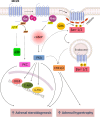Intracellular signaling mechanisms of the melanocortin receptors: current state of the art
- PMID: 25504085
- PMCID: PMC11113477
- DOI: 10.1007/s00018-014-1800-3
Intracellular signaling mechanisms of the melanocortin receptors: current state of the art
Abstract
The melanocortin system is composed by the agonists adrenocorticotropic hormone and α, β and γ-melanocyte-stimulating hormone, and two naturally occurring antagonists, agouti and agouti-related protein. These ligands act by interaction with a family of five melanocortin receptors (MCRs), assisted by MCRs accessory proteins (MRAPs). MCRs stimulation activates different signaling pathways that mediate a diverse array of physiological processes, including pigmentation, energy metabolism, inflammation and exocrine secretion. This review focuses on the regulatory mechanisms of MCRs signaling, highlighting the differences among the five receptors. MCRs signal through G-dependent and independent mechanisms and their functional coupling to agonists at the cell surface is regulated by interacting proteins, namely MRAPs and β-arrestins. The knowledge of the distinct modulation pattern of MCRs signaling and function may be helpful for the future design of novel drugs able to combine specificity, safety and effectiveness in the course of their therapeutic use.
Conflict of interest statement
The authors have no conflict of interest.
Figures






Similar articles
-
Ligands for Melanocortin Receptors: Beyond Melanocyte-Stimulating Hormones and Adrenocorticotropin.Biomolecules. 2022 Oct 1;12(10):1407. doi: 10.3390/biom12101407. Biomolecules. 2022. PMID: 36291616 Free PMC article. Review.
-
Regulation of Melanocortin-3 and -4 Receptors by Isoforms of Melanocortin-2 Receptor Accessory Protein 1 and 2.Biomolecules. 2022 Feb 2;12(2):244. doi: 10.3390/biom12020244. Biomolecules. 2022. PMID: 35204745 Free PMC article.
-
60 YEARS OF POMC: Melanocortin receptors: evolution of ligand selectivity for melanocortin peptides.J Mol Endocrinol. 2016 May;56(4):T119-33. doi: 10.1530/JME-15-0292. Epub 2016 Jan 20. J Mol Endocrinol. 2016. PMID: 26792827 Review.
-
Modulation of Canine Melanocortin-3 and -4 Receptors by Melanocortin-2 Receptor Accessory Protein 1 and 2.Biomolecules. 2022 Nov 1;12(11):1608. doi: 10.3390/biom12111608. Biomolecules. 2022. PMID: 36358958 Free PMC article.
-
Constitutive activity of neural melanocortin receptors.Methods Enzymol. 2010;484:267-79. doi: 10.1016/B978-0-12-381298-8.00014-9. Methods Enzymol. 2010. PMID: 21036237
Cited by
-
Melanocortin receptor agonists MCR1-5 protect photoreceptors from high-glucose damage and restore antioxidant enzymes in primary retinal cell culture.J Cell Mol Med. 2017 May;21(5):968-974. doi: 10.1111/jcmm.13036. Epub 2016 Dec 20. J Cell Mol Med. 2017. PMID: 27998021 Free PMC article.
-
Melanocortins, Melanocortin Receptors and Multiple Sclerosis.Brain Sci. 2017 Aug 14;7(8):104. doi: 10.3390/brainsci7080104. Brain Sci. 2017. PMID: 28805746 Free PMC article. Review.
-
G-Protein-Coupled Receptors in Rheumatoid Arthritis: Recent Insights into Mechanisms and Functional Roles.Front Immunol. 2022 Jul 8;13:907733. doi: 10.3389/fimmu.2022.907733. eCollection 2022. Front Immunol. 2022. PMID: 35874704 Free PMC article. Review.
-
Oxytocin Neurons Enable Melanocortin Regulation of Male Sexual Function in Mice.Mol Neurobiol. 2019 Sep;56(9):6310-6323. doi: 10.1007/s12035-019-1514-5. Epub 2019 Feb 12. Mol Neurobiol. 2019. PMID: 30756300 Free PMC article.
-
Gamma-Aminobutyric Acid (GABA) Inhibits α-Melanocyte-Stimulating Hormone-Induced Melanogenesis through GABAA and GABAB Receptors.Int J Mol Sci. 2021 Jul 31;22(15):8257. doi: 10.3390/ijms22158257. Int J Mol Sci. 2021. PMID: 34361022 Free PMC article.
References
-
- Cooray SN, Clark AJ. Melanocortin receptors and their accessory proteins. Mol Cell Endocrinol. 2011;331:215–221. - PubMed
-
- Smith AI, Funder JW Proopiomelanocortin processing in the pituitary, central nervous system, and peripheral tissues. Endocr Rev. 1988;9:159–179. - PubMed
-
- Bultman SJ, Michaud EJ, Woychik RP. Molecular characterization of the mouse agouti locus. Cell. 1992;71:1195–1204. - PubMed
-
- Wilson BD, Ollmann MM, Kang L, Stoffel M, Bell GI, Barsh GS. Structure and function of ASP, the human homolog of the mouse agouti gene. Hum Mol Genet. 1995;4:223–230. - PubMed
-
- Voisey J, Kelly G, Van Daal A. Agouti signal protein regulation in human melanoma cells. Pigment Cell Res. 2003;16:65–71. - PubMed
Publication types
MeSH terms
Substances
LinkOut - more resources
Full Text Sources
Other Literature Sources

